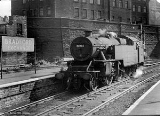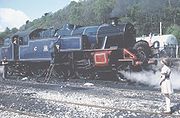
LMS Fairburn 2-6-4T
Encyclopedia
The London Midland and Scottish Railway (LMS) Fairburn Tank 2-6-4T
steam locomotive
s are a class of steam locomotive
. They were designed by Charles E. Fairburn for the London Midland and Scottish Railway (LMS). 277 of these locomotives were built between 1945–1951, numbered in the range 42050–42186, (4)2187–(4)2299, (4)2673–(4)4699.
LMS Stanier 2-6-4T
built from 1935–1943. It was also the basis for the later British Rail
Standard Class 4 tank
. They were used mainly for suburban passenger trains. Forty-one examples of the class were constructed by Brighton railway works
for service on the Southern Region of British Railways
in 1950 and 1951, replacing earlier designs. The majority of these remained on the Southern Region throughout their workling lives.
 Two of the Brighton-built locomotives, nos. 42073 and 42085, survive in preservation on the Lakeside & Haverthwaite Railway, though 42085 recently underwent repairs at the Great Central Railway.
Two of the Brighton-built locomotives, nos. 42073 and 42085, survive in preservation on the Lakeside & Haverthwaite Railway, though 42085 recently underwent repairs at the Great Central Railway.
In its early days, 2085 carried Caledonian Railway
blue livery, complete with an oval brass Caledonian number plate. This attractive livery was popular with the public, but strongly divided opinions in the preservation movement for its inaccuracy. At the same time, 2073 was painted in LNWR blackberry black, which was comparably anachronistic but generated less hostility as it did at least resemble the original livery.
produces a 00 Gauge model of the Fairburn 4MT in LMS Black as well as early and late BR, numbered as 42073.
Ace Trains have produced an O-gauge model of 2085 in its early-preservation Caledonian Railway blue livery, although the model is actually of a Stanier designed 2-6-4T.
2-6-4
Under the Whyte notation for the classification of steam locomotives, a 2-6-4 locomotive has two leading wheels, six coupled driving wheels and four trailing wheels...
steam locomotive
Steam locomotive
A steam locomotive is a railway locomotive that produces its power through a steam engine. These locomotives are fueled by burning some combustible material, usually coal, wood or oil, to produce steam in a boiler, which drives the steam engine...
s are a class of steam locomotive
Steam locomotive
A steam locomotive is a railway locomotive that produces its power through a steam engine. These locomotives are fueled by burning some combustible material, usually coal, wood or oil, to produce steam in a boiler, which drives the steam engine...
. They were designed by Charles E. Fairburn for the London Midland and Scottish Railway (LMS). 277 of these locomotives were built between 1945–1951, numbered in the range 42050–42186, (4)2187–(4)2299, (4)2673–(4)4699.
Overview
This design was based on the earlier StanierWilliam Stanier
Sir William Arthur Stanier, FRS was Chief Mechanical Engineer of the London, Midland and Scottish Railway.- Biography :...
LMS Stanier 2-6-4T
LMS Stanier 2-6-4T
LMS Stanier 2-6-4T may refer to two related types of steam locomotive, considered separately:* LMS 2-Cylindered Stanier 2-6-4T * LMS 3-Cylindered Stanier 2-6-4T...
built from 1935–1943. It was also the basis for the later British Rail
British Rail
British Railways , which from 1965 traded as British Rail, was the operator of most of the rail transport in Great Britain between 1948 and 1997. It was formed from the nationalisation of the "Big Four" British railway companies and lasted until the gradual privatisation of British Rail, in stages...
Standard Class 4 tank
BR standard class 4 tank
The British Railways Standard Class 4 tank was a class of steam locomotive, one of the BR standard classes built during the 1950s. They were used primarily on commuter and outer suburban services.- Background :...
. They were used mainly for suburban passenger trains. Forty-one examples of the class were constructed by Brighton railway works
Brighton railway works
Brighton railway works was one of the earliest railway-owned locomotive repair works, founded in 1840 by the London and Brighton Railway in Brighton, England, and thus pre-dating the more famous railway works at Crewe, Doncaster and Swindon...
for service on the Southern Region of British Railways
Southern Region of British Railways
The Southern Region was a region of British Railways from 1948. The region ceased to be an operating unit in its own right in the 1980s and was wound up at the end of 1992. The region covered south London, southern England and the south coast, including the busy commuter belt areas of Kent, Sussex...
in 1950 and 1951, replacing earlier designs. The majority of these remained on the Southern Region throughout their workling lives.
| Number | Lot No. | Date built | Built by | |
|---|---|---|---|---|
| LMS | BR | |||
| - | 42050–65 | 210 | 1950 | Derby Derby Works The Midland Railway Locomotive Works, known locally as "the loco" comprised a number of British manufacturing facilities in Derby building locomotives and, initially, rolling stock in Derby, UK.-Early days:... |
| - | 42066–78 | 3536 | 1950 | Brighton |
| - | 42079–95 | 3536 | 1951 | Brighton |
| - | 42096–106 | 3491 | 1950 | Brighton |
| - | 42107–32 | 202 | 1949 | Derby Derby Works The Midland Railway Locomotive Works, known locally as "the loco" comprised a number of British manufacturing facilities in Derby building locomotives and, initially, rolling stock in Derby, UK.-Early days:... |
| - | 42133–46 | 202 | 1950 | Derby Derby Works The Midland Railway Locomotive Works, known locally as "the loco" comprised a number of British manufacturing facilities in Derby building locomotives and, initially, rolling stock in Derby, UK.-Early days:... |
| - | 42146–82 | 196 | 1948 | Derby Derby Works The Midland Railway Locomotive Works, known locally as "the loco" comprised a number of British manufacturing facilities in Derby building locomotives and, initially, rolling stock in Derby, UK.-Early days:... |
| - | 42183–6 | 196 | 1949 | Derby Derby Works The Midland Railway Locomotive Works, known locally as "the loco" comprised a number of British manufacturing facilities in Derby building locomotives and, initially, rolling stock in Derby, UK.-Early days:... |
| 2187–9 | 42187–9 | 186 | 1947 | Derby Derby Works The Midland Railway Locomotive Works, known locally as "the loco" comprised a number of British manufacturing facilities in Derby building locomotives and, initially, rolling stock in Derby, UK.-Early days:... |
| 2190–9 | 42190–9 | 186 | 1948 | Derby Derby Works The Midland Railway Locomotive Works, known locally as "the loco" comprised a number of British manufacturing facilities in Derby building locomotives and, initially, rolling stock in Derby, UK.-Early days:... |
| 2200–17 | 42200–17 | 177 | 1945 | Derby Derby Works The Midland Railway Locomotive Works, known locally as "the loco" comprised a number of British manufacturing facilities in Derby building locomotives and, initially, rolling stock in Derby, UK.-Early days:... |
| 2218–22 | 42218–22 | 177 | 1946 | Derby Derby Works The Midland Railway Locomotive Works, known locally as "the loco" comprised a number of British manufacturing facilities in Derby building locomotives and, initially, rolling stock in Derby, UK.-Early days:... |
| 2223–64 | 42223–64 | 185 | 1946 | Derby Derby Works The Midland Railway Locomotive Works, known locally as "the loco" comprised a number of British manufacturing facilities in Derby building locomotives and, initially, rolling stock in Derby, UK.-Early days:... |
| 2265–72 | 42265–72 | 185 | 1947 | Derby Derby Works The Midland Railway Locomotive Works, known locally as "the loco" comprised a number of British manufacturing facilities in Derby building locomotives and, initially, rolling stock in Derby, UK.-Early days:... |
| 2273–99 | 42273–99 | 186 | 1947 | Derby Derby Works The Midland Railway Locomotive Works, known locally as "the loco" comprised a number of British manufacturing facilities in Derby building locomotives and, initially, rolling stock in Derby, UK.-Early days:... |
| 2673–99 | 42673–99 | 177 | 1945 | Derby Derby Works The Midland Railway Locomotive Works, known locally as "the loco" comprised a number of British manufacturing facilities in Derby building locomotives and, initially, rolling stock in Derby, UK.-Early days:... |
Preservation

In its early days, 2085 carried Caledonian Railway
Caledonian Railway
The Caledonian Railway was a major Scottish railway company. It was formed in the early 19th century and it was absorbed almost a century later into the London, Midland and Scottish Railway, in the 1923 railway grouping, by means of the Railways Act 1921...
blue livery, complete with an oval brass Caledonian number plate. This attractive livery was popular with the public, but strongly divided opinions in the preservation movement for its inaccuracy. At the same time, 2073 was painted in LNWR blackberry black, which was comparably anachronistic but generated less hostility as it did at least resemble the original livery.
Models
BachmannBachmann
Bachmann is a surname of Switzerland and Germany. It originates as a description of the bearer as dwelling near a brook , such as a farm "Hofstatt am Bach" also called "Bachmanns Hofstatt" near Hinwil or Dürnten , or the "Hof zum Bach" near Richterswil .Low German variants of the name include...
produces a 00 Gauge model of the Fairburn 4MT in LMS Black as well as early and late BR, numbered as 42073.
Ace Trains have produced an O-gauge model of 2085 in its early-preservation Caledonian Railway blue livery, although the model is actually of a Stanier designed 2-6-4T.

